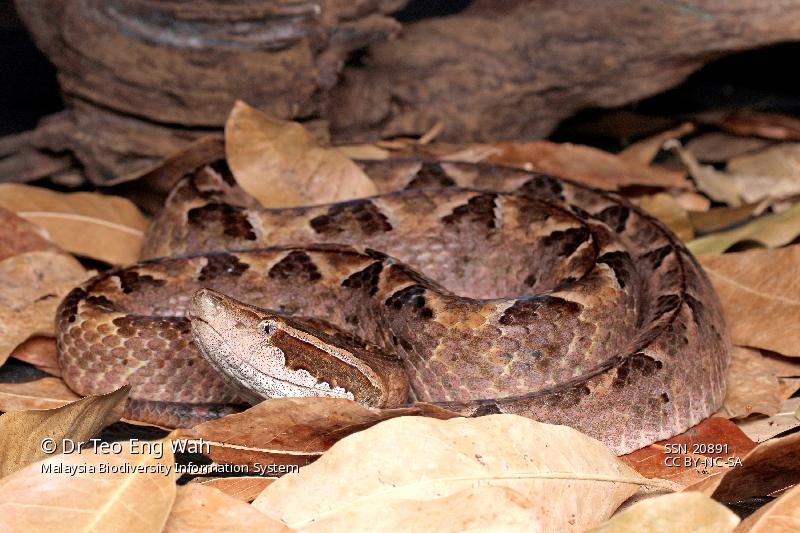Calloselasma rhodostoma (Kuhl, 1824) by Ajla Rafidah Baharom (Main Author), Kaviarasu Munian (Main Author) & Lee Su See (Editor)
The Malayan Pit Viper or Ular Kapak Daun in Malay, is a species of pit viper found in northern parts of Peninsular Malaysia. Calloselama rhodostoma is a monotypic species in its genus in the family Viperidae (Cox et al., 2012). Members of the Viperidae include vipers and pit vipers which are venomous, and have a pair of retractile hollow fangs that can be folded when not in use (Das, 2012). Vipers possess potent haemotoxic venom and bites from the Malayan Pit Viper are potentially fatal. Snakes of this family are also generally slow-moving and can be easily distinguished from other snake families by their enlarged, triangular-shaped heads with narrow necks. However, some snakes from other families such as Colubridae are also known to mimic the triangular head shape of vipers as a defence mechanism against predators (Valkonen et al., 2011). In comparison with other vipers, pit vipers differ by having a specialised 'pit' organ between the nostrils and the eyes which serves as a heat sensing system. The thermal receptor in the organ enables the snake to sense thermal cues (Das, 2012) and judge the size and location of its prey. An adult Malayan Pit Viper has a dark brown forehead and dark post-ocular stripe that extends to the base of its jaws; whitish supralabials and slightly curved upward and pointed snout; its eyes are small with vertical pupils. Vipers are typically known to have keeled dorsal scales but the Malayan Pit Viper's dorsal scales are smooth. Its moderately stout body is reddish-brown or purplish-brown on top with a series of dark brown sub-triangular marks on each side with their tips meeting or alternating. The snake has pale brown flanks speckled with dark brown and a pinkish cream belly mottled with brown (Das, 2012). The female is generally larger than the male measuring about 100 cm in length compared to the male, measuring about 75cm long (Cox et al., 2012). The Malayan Pit Viper is a terrestrial, nocturnal species. Its colouration and pattern serves as excellent camouflage among fallen, dried leaves while lying in ambush for its unsuspecting prey. Its prey varies from small mammals, rodents, frogs, lizards, and probably any other small animal that comes within its striking range. This species is oviparous, meaning that it reproduces by laying eggs (Cox et al., 2012). Its nesting behaviour is poorly known, but observations in a forested area in Thailand reported that a maternal female attended to its clutch of eggs and remained coiled around the eggs for the entire incubation period (Hill et al., 2006). This shows that this species exhibits parental care in the form of nest attendance. The Malayan Pit Viper is native to Cambodia, Indonesia (Java only), Laos, Malaysia (northwest Peninsular Malaysia), Thailand and Vietnam. According to Das (2012), this snake inhabits dry lowland forests up to sub-montane forests below 1,524 m above sea level, and is sometimes found in plantations with dense undergrowth and rocky areas. It is a common species within its range. The Malayan Pit Viper is listed as Least Concern (LC) according to the International Union for Conservation of Nature (IUCN) due to its stable overall population and widespread distribution although deforestation activities for logging or agriculture may affect its sub-populations (Grismer & Chan-Ard, 2012).
References
Published on 31 May 2018. Updated by Mr. Abdul Razak Mohd Nor Rasid, Ms. Ajla Rafidah Baharom, Mrs. Nurfarhana Hizan Binti Hijas & Mr. Tan Kok Kiat |

